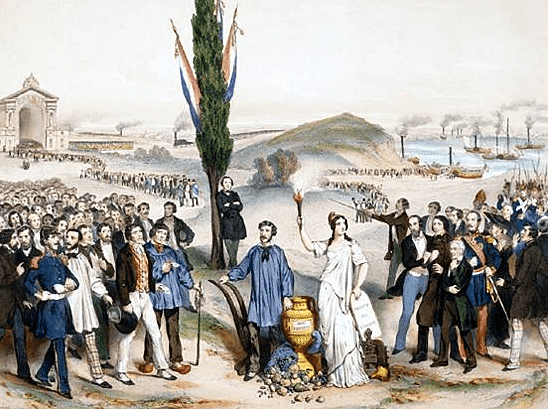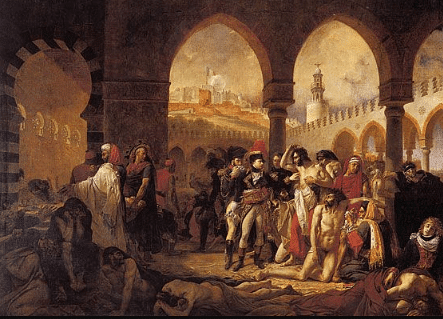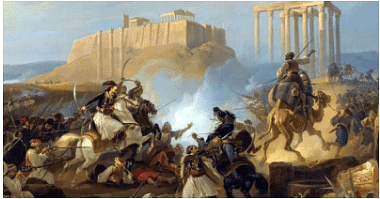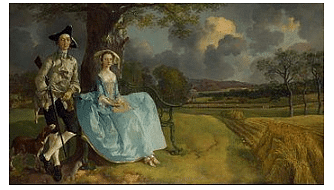Class 10 History Chapter 1 Extra Question Answers - The Rise of Nationalism in Europe
Short Answer Type Questions
Q 1. Explain liberalism in political and economic fields prevailing in Europe in the 19th century.
The term ‘liberalism’ derives from the Latin root ‘Liber’, meaning free. It was an ideology that stood for freedom for the individual and equality of all before the law.
Politically, liberalism stood for:
(a) Constitution.
(b) A representative government ruling by consent.
(c) A parliamentary system.
(d) Right to vote and get elected granted to property-owning men.
(e) End of the privileges of aristocracy and the clergy. Drawback of liberalism was that it did not grant equal rights to men and women, women had to struggle for their political rights.
Economically, liberalism stood for:
(a) Freedom of markets.
(b) End of state restrictions on movement of goods and capital.
(c) A customs union or Zollverein was formed by Prussia in 1834, which many German states joined.
(d) This union reduced the number of currencies from over thirty to two and abolished tariff barriers.
(e) A network of railways led to great mobility and gave an impetus to national unity. It boosted economic nationalism.
Q 2. How did Romanticism seek to develop a particular form of nationalist sentiment during 18th century? Explain.
OR
“Culture played an important role in creating the idea of the nation in Europe.” Support the statement with examples.
Romanticism referred to a cultural movement that sought to develop a particular form of national sentiment.
Romanticism Movement
- Romantic artists and poets generally criticized the glorification of reason and science.
- They focussed on emotions, intuition and mystical feelings. Their effort was to create a sense of a shared collective heritage, a common cultural past as the basis of a nation.
- Some German Romantics like Johann Gottfried Herder thought that through folk songs, folk poetry and folk dance, the true spirit of the nation could be popularized. He claimed that true German culture was to be discovered among the common people.
Q 3. In which year was the unification of Italy completed? Mention two features of the unification movement.
The unification of Italy took place in 1860.
Two features of the unification movement are:
(a) Italian unification was the social and political movement that agglomerated different states of the Italian peninsula into the single state of Italy in the 19th Century.
(b) After the fall of the Roman Empire Italy gradually developed into a system of the city-state.
Unification of Italy
Q 4. Why were the 1830s called the years of great economic hardship in Europe? Give any three reasons.
The 1830s were the years of great economic hardship in Europe due to the following reasons:
(a) There was an enormous increase in population all over Europe.
(b) There were more seekers of jobs than employment.
(c) People migrated from rural areas to the cities to live in overcrowded slums.
(d) There was stiff competition between the products of small producers and products imported from England where goods were made by machines as industrialization had already taken place there.
Q 5. Explain any three reasons for the nationalist upsurge in the 19th Century Europe.
Reasons for the Nationalist upsurge in the 19th-Century Europe:
(a) Oppression of people under absolute rulers.
(b) Liberal ideas spread by well-known philosophers and leaders.
(c) The French Revolution inspired the people to fight for freedom. The slogan ‘Liberty, Equality and Fraternity’ became the clarion call for the common people.
Q 6. Explain the role of language in developing nationalist sentiments in Europe.
- At that time most of the people were illiterate. They were able to understand only vernacular regional or simple language. Thus, vernacular or regional language carried out the modern nationalist message to a large audience easily.
- The message of nationalist sentiment was conveyed most effectively in the vernacular language. Folklore, folk tales and the activities concerned with vernacular language gave the feeling of nationalism and tied the people by the thread of national love and honour.
Q 7. “Italy had a long history of political fragmentation”. Support the statement by giving any three points.
The reasons are as follows:
(a) Italians were scattered over several dynastic states as well as the multinational Habsburg Empire.
(b) During the middle of the 19th century, Italy was divided into seven states, of which only one state - Sardinia - Piedmont - was ruled by an Italian princely house.
(c) The north was under Austrian Habsburgs, the center was ruled by the Pope and the southern regions were under the domination of the Bourbon kings of Spain.
Q 8. Explain how Ireland got incorporated into the United Kingdom in 1801? What were the symbols of this new British nation?
The population of Ireland was divided into two categories - Catholics and Protestants. The British helped the Protestants to dominate the large Catholic population. Catholics opposed that suppression under the leadership of Wolfe Tone and his United Irishmen but they failed. At last, Ireland was forcibly incorporated into the United Kingdom in 1801. The symbols of new British Kingdom (Nation) was - the British flag, i.e., Union Jack, the national anthem, i.e., God Save the King, and the English language was actively promoted. Finally, the Irish people were forced to live as subordinate in their own country.
Long Answer Type Questions
Q 1. After 1817 why was the Balkan region the most serious source of nationalist tension in Europe? Explain giving four reasons.
The Balkan region was a source of tension because of the following reasons:
(a) The Balkan region comprised modern-day Romania, Bulgaria, Albania, Greece, Macedonia, Croatia, Bosnia-Herzegovina, Slovenia, Serbia and Montenegro, and its inhabitants were broadly called the Slavs.
(b) Large part of the Balkans was under the Ottoman Empire and the disintegration of which created an explosive situation. One by one its European subject nationalities broke away from its control and declared independence.
(c) Balkan peoples based their claims for independence or political rights on nationality and used history to prove that they were independent but subsequently subjugated.
(d) The Balkan states were fiercely jealous of each other & hoped to gain territory.
(e) Matters complicated because of intense rivalry among the European powers over trade and colonies as well as competition regarding naval and military might. This led to a series of wars in the region and finally the First World War.
Q 2. Explain any four provisions of Napoleon’s Civil Code of 1804.
OR
State any three provisions of the Civil Code of 1804.
Napoleon incorporated revolutionary principles in the administrative field to make the whole system more rational and effective. His civil code of 1804 was known as the Napoleonic Code.
(a) First, he did away with all the privileges based on birth. Everyone became equal before the law. He abolished the feudal system and freed peasants from serfdom and manorial duties.
(b) He secured the right to property.
(c) Peasants, artisans, workers and new businessmen found newfound freedom as guild restrictions were removed in towns as well.
(d) Uniform laws, standardized weights and measures, a common national currency facilitated the movement and exchange of goods and capital from one region to another.
Q 3. How was the Habsburg Empire a patchwork of many different regions and people in Europe? Explain.
- In mid-eighteenth century Europe, there were no 'nation-states' as we know them today. Eastern and Central Europe were under autocratic monarchies, having people of diverse ethnic groups.
- The Habsburg Empire was one such example. It ruled over Austria-Hungary, a patchwork of many different regions and peoples. It included the Alpine regions - the Tyrol, Austria, and Switzerland - as well as Bohemia, where the aristocracy was predominantly German-speaking. It also included the Italian-speaking provinces of Lombardy and Venetia.
- In Hungary, half the population spoke Magyar, while the other half spoke a variety of dialects. In Galicia, the aristocracy spoke Polish.
- Besides these three dominant groups, there also lived within the territories a mass of subject peasant peoples - Bohemians, Slovaks to the north, Slovenes in Carniola, Croats to the south, the Romans to the east in Transylvania. The only tie binding these diverse groups together was a common allegiance to the emperor.
Q 4. When did the first clear-cut expression of nationalism come in France? How did the French Revolution lead to the transfer of sovereignty from the monarchy to a body of French citizens? Explain any three measures taken by the French revolutionaries in this regard.
(a) The first clear-cut expression of nationalism came to France with the French Revolution of 1789.
(b) The French revolutionaries introduced various measures and practices which proclaimed that it was the people who would henceforth constitute the nation and shape its destiny.
(c) The ideas of la Patrie (the fatherland) and le citoyen (the citizen) emphasized the notion of a united community enjoying equal rights under a constitution. A French flag, the tricolour, was chosen to replace the royal standard.
(d) The Estates-General was elected by the body of active citizens and renamed National Assembly.
(e) A centralized administrative system was put in place and it formulated uniform laws for all its citizens.
Q 5. How has French artist, Frederic Sorrieu, visualized in his first print, of the series of four prints, his dream of a world made up of 'democratic and social republics'? Explain.
OR
Describe Frederic Sorrieu’s utopian vision of the world as depicted in his painting in 1848.
 Frederic Sorrieu's Painting
Frederic Sorrieu's Painting
The French artist, Fredrick Sorrieu prepared a series of four prints visualizing his dream of the world made up of ‘democratic and social republics’.
(a) His First Print showed people of Europe and America - men and women of all ages and social classes - marching in a long train, and offering homage to the Statue of Liberty as they pass by it.
(b) Liberty is of course personified as a woman, bearing the torch of Enlightenment in one hand and the charter of the Rights of Man in the other. (The artists of this time of the French Revolution portrayed Liberty as a female figure).
(c) On the earth, in the foreground of the image, lay the shattered remains of the symbols of Absolute institutions. Leading the procession, way past the Statue of Liberty, are the United States and Switzerland which were at that time already nation-states.
(d) In his print of Sorrieu, people of the world are grouped together as distinct nations, identified through their flags and national costume. France, distinguished by its tricolour flag, has just reached the statue, and she is followed by Germany with their black and gold flag. (Germany was not yet united, but in 1848, when this painting was made, it expressed the hopes of the nation.)
(e) People of Austria, kingdoms of two Sicilies, Lombardy, Poland, England, Ireland, Hungary and Russia follow in that order. From the heavens, Christ, saints and angels gaze upon the scene. They have been used to symbolize the fraternity among the nations of the world.
Q 6. Explain any four measures introduced by French revolutionaries to create a sense of collective identity among the people of France.
The French revolutionaries introduced various measures to create a sense of collective identity.
(a) The idea of la Patrie (the fatherland) and le citoyen (the citizen) emphasised the idea of a united community enjoying equal rights under the Constitution.
(b) A new French flag, the tricolour, was chosen to replace the old royal standard.
(c) The Estates-General was elected by the body of active citizens and renamed the National Assembly.
(d) New hymns were composed, oaths taken and martyrs commemorated in the name of the nation.
Q 7. Describe four stages of unification of Germany.
(a) Nationalist feelings were widespread among middle-class Germans, who in 1848, tried to unite the different regions of the German confederation into a nation-state.
(b) From then on, Prussia took on the leadership of the movement for national unification. It's chief minister (Chancellor) Otto von Bismarck, the architect of this process, carried it out, with the help of the Prussian army and bureaucracy.
German Unification
(c) Three wars were fought over a span of seven years against Austria, Denmark and France, which ended in Prussian victory and completed the process of unification.
(d) In January 1871, the Prussian King William I was proclaimed German emperor in a ceremony held at Versailles. On 18 January 1871, the new German empire headed by Kaiser Wilhelm of Prussia was proclaimed.
Q 8. How did culture play an important role in creating the idea of a nation in Europe? Explain with four examples.
The feeling of nationalism was strengthened, developed and given encouragement by art, music, literature, drama. These played a big role in it. Their contribution was equal to the heroic battles fought by heroes.
(a) The Romantics like the German philosopher Johann Gottfried Herder believed that true German culture could be discovered only among the common people - das volk.
(b) Language played a very important role in boosting nationalism. The Polish people opposed the Russian occupation and the ban on Polish language, by using it in the Churches for all religious ceremonies and for religious instruction. The Polish language became a weapon in the hands of the nationalists and no amount of Russian atrocities could stop them. Two Germans, Grimm Brothers, used stories and folktales written in German language to promote the German spirit against the domination of the French. Grimm’s fairy tales became instant classics.
(c) Operas and music, like that of the Polish Karol Kurpinski, kept the national spirit alive.
(d) Folk dances like the polonaise and mazurka became national symbols.
Q 9. Mention any two economic obstacles that the liberal nationalists wanted to overcome. In what way did the Zollverein customs union of 1834 try to overcome these shortcomings?
- During the early nineteenth century, Europe was closely allied to the ideology of liberalism. In reference to economy this liberalism denotes freedom of market, fewer restrictions of state on the movement of goods and capitals. The main demand of the newly emerging middle class was to get rid of the economic problems.
- Existence of countless small principalities, different currencies, number of customs barriers created obstacles to economic exchange and growth for the new commercial classes. To sort out that problem Prussia including with most of the German states formed a customs union or Zollverein in 1834.
- The Zollverein abolished tariff barriers, reduced number of currencies, create a network of railways for fast and heavy mobility. So a single solution for all these economic problems was known by the name of Zollverein.
Q 10. What is the significance of 1848 for France and the rest of Europe? What did the liberals demand?
- With many revolts like revolts of the poor, unemployed workers and starving peasants during 1848 in Europe, the educated middle class of France also started a revolution for the abdication of the monarch and a republic based on universal male suffrage had been proclaimed.
- In other parts of Europe, men and women of the liberal middle classes combined their demands for constitutionalism with national unification. They took advantage of the growing popular unrest to push their demands for the creation of a nation state on parliamentary principles - a constitution, freedom of the press and freedom of association.
- The issue of extending political rights to women was most controversial subject matter within the liberal movement in which large number of women had participated actively.
Q 11. How did the Greek War of Independence mobilized nationalist feeling among the educated elite across Europe? Give four points.
(a) Greece was part of the Ottoman Empire since the fifteenth century. The growth of revolutionary nationalism in Europe motivated the Greeks to start a struggle for independence which began in 1821.
(b) Reaction of the struggle inspired the educated elite class of Europe and filled them, with nationalistic feeling.
(c) Greece got support from other Greeks also residing in different countries. Poets and artists lauded Greece as the cradle of European civilization and mobilized public opinion to support its struggle against a Muslim empire.
(d) English poet Lord Byron organized fund and participated in the war. Finally, in 1832 Greece was recognized as an independent nation by the Treaty of Constantinople.
Greek War of Independence
Q 12. “Till the mid-eighteenth century, there were no nation-states in Europe.” Support the statement with four examples.
- During the mid-eighteenth century, there were no nation-states in Europe, Germany, Italy and Switzerland were ruled by different rulers with autonomous territories.
- Autocratic monarchies were there in the eastern and central part of Europe. These areas were occupied by different people. They did not see themselves as sharing a collective identity or common culture. They spoke different languages and belonged to different ethnic groups, like the area of Austria - Hungary included the Alpine region the Tyrol. Sudetenland and Bohemia were dominated by German-speaking people. It also included the province of Lombardy and Venetia which had Italian speaking people. In Hungary, half of the population spoke Magyar and the other half of the population spoke different dialects. In the part of Galicia, the aristocratic class spoke Polish.
- Besides these three dominant groups, a mass of subject peasant people like - Romans to the east in Transylvania, Bohemians and Slovaks to the north, Slovenes in Carniola and the Croats to the south lived within the boundary. The only tie binding those different groups together was a common allegiance to the emperor.
Q 13. What was the main objective of the Treaty of Vienna of 1815? Mention any three important features of the treaty.
The main objective of the treaty of Vienna was to nullify all the changes that had come into existence during the Napoleonic wars. The Bourbon dynasty restores its power which had been deposed during the French Revolution. To prevent the expansion of France in the future, a number of states were set up on the boundaries of France.
Treaty of Vienna
The kingdom of the Netherland including Belgium was set up in the north and Genoa including Piedmont established in the south. Prussia was given important new territories on the western frontier, while Austria was given control of northern Italy. The German confederation of 39 states which was set up by Napoleon was left untouched. Prussia was given to Russia. The main intention was behind that set up was to restore the monarchies that had been overthrown by Napoleon and create a new conservative order in Europe.
Q 14. Describe any four features of the landed aristocracy class of the European continent.
The European continent was dominated by the landed aristocratic class socially as well as politically. This landed aristocratic class was united by a common way of life that cut across regional divisions. They had their own estates and townhouses in the countryside. The families of the landed aristocratic class got married within their own class.
The landed aristocratic class
The occupation of the majority population was agriculture. Europe was divided into two major parts on the basis of occupation. The western part was served by tenants and small owners of land or small landlords. While in eastern and central Europe the pattern of landholding was characterized by the vast estate which was cultivated by serfs.
Q 15. How was the Habsburg Empire a patchwork of many different regions and peoples in Europe? Explain
- The Habsburg Empire included the Alpine regions - the Tyrol, Austria, Sudetenland and Bohemia. It also included the Italian - speaking provinces of Lombardy and Venetia.
- In Hungary, half of the population spoke Magyar while other half spoke a variety of dialects.
- In Galicia, the aristocracy spoke Polish. Besides, there also lived a mass of subject peasant people-Bohemians, Slovaks, Slovenes, Croats, and the Romans.
- The only tie binding these diverse groups together was a common allegiance to the emperor.
|
63 videos|445 docs|87 tests
|
FAQs on Class 10 History Chapter 1 Extra Question Answers - The Rise of Nationalism in Europe
| 1. What is the meaning of nationalism? |  |
| 2. What were the causes of the rise of nationalism in Europe? |  |
| 3. What were the consequences of the rise of nationalism in Europe? |  |
| 4. How did the French Revolution contribute to the rise of nationalism in Europe? |  |
| 5. What were the challenges faced by the newly formed nation-states in Europe? |  |

|
Explore Courses for Class 10 exam
|

|
























